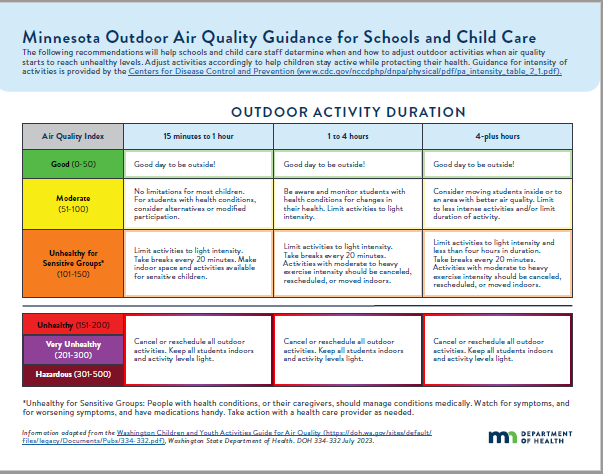Asthma
- Asthma Home
- About Asthma
- Minnesota Asthma Alliance
- Managing Asthma
- Data
- For Schools
- For Health Care Professionals
- For Homes
- For Communities
- For Workplaces
- Who We Are
- COVID-19 and Asthma
Resources
- Athletes and Asthma: The Community Coach's Role
- Asthma Education Resources for American Indian Communities
- Engaging the Latine Community Around Asthma
- Outdoor Air Quality Guidance for Schools and Child Care
- Asthma Home-Based Services
- Strategic Framework
- Asthma Home-Based Services Toolkit, Manual and Client Curriculum
Related Sites
Minnesota Outdoor Air Quality Guidance for Schools and Child Care
Wildfires can generate enormous amounts of smoke that produce poor air quality for Minnesota. Wildfires can make air unhealthy and harm people, including those with asthma, heart or lung disease, older adults, and children. While air pollution affects everyone, children and youth are particularly vulnerable because their bodies are still developing and they breathe in more air than adults for their body weight.
MDH created this guidance document in a collaborative effort to work alongside schools and child care facilities statewide. The goal of this outdoor air guidance is to lower the risk of negative impacts to children’s health due to poor air quality events.

- The following recommendations are to help schools and child care staff determine when and how to adjust outdoor physical activities when air quality starts to reach unhealthy levels.
- This guidance is optional and each school and child care center can use it as a tool when making decisions around balancing healthy outdoor activities that keep children active against the potential harms of poor air quality.
- Download the Minnesota Outdoor Air Quality Guidance for Schools and Child Care (PDF)
Who is the guidance for?
This guidance is intended for professionals, providers, and others working with children in schools (K-12, public, private, charter, tribal, etc.) and various child care facilities (day care, after school programs, etc.).
Check the air quality in your community
Stay informed about your local air quality conditions by visiting the Minnesota Pollution Control Agency Current Air Quality Conditions where you can download the AirNow mobile app for Android or Apple.
MDH Related Resources
- Air Quality, Climate and Health (MDH)
- Asthma (MDH)
- Cardiovascular Health (MDH)
- Minnesota Environmental Public Health Tracking (MDH)
- Wildfire Smoke (MDH)
- Athletes and Asthma: The Community Coach’s Role (MDH) A 35-minute online asthma training course for youth sport coaches and anyone who supports youth programming.
Additional Resources
- Wildfire Smoke, State Policies for Reducing Indoor Exposure (Environmental Law Institute)
- Wildfire Smoke, A Guide for Public Health Officials (Washington Department of Public Health, U.S. EPA)
- Wildfires and Indoor Air Quality,(IAQ) (U.S. EPA)
- Wildfires, (American Academy of Pediatrics)
- Wildfire Smoke and Children (CDC)
- Heat Risk Dashboard | NCEH | (CDC)
- Who is Most Affected by Outdoor Air Pollution (American Lung Association)
Physical Activities Defined by Level of Intensity Guidance
Use the Minnesota Outdoor Air Quality Guidance for Schools and Child Care and the following resources to align your physical activities with the current air quality conditions in your area.
- Physical Activities Defined by Level of Intensity (PDF) - MDH adapted this information in accordance with the Centers for Disease Control and Prevention (CDC) and American College of Sports Medicine.
- Physical Activity Guidelines for Americans, (CDC)
- Physical Activity Basics: What Counts for Children and Teens (CDC)
Wildfire Resources: Pediatric Environmental Health Specialty Units
To address the health risks to children from wildfires, the Pediatric Environmental Health Specialty Units (PEHSU), a network of experts in pediatrics, allergy/immunology, neurodevelopment, toxicology, occupational and environmental medicine, nursing, and reproductive health, and other specialized areas along with input from the AAP Council on Environmental Health and Climate Change, have developed the following fact sheets:
- Information on Health Risks of Wildfires for Children - Acute Phase - Guidance for Health Professionals
- Wildfires and Mask Use
Wildfire Presentation - University of Minnesota
Questions
Please email us at health.asthma@state.mn.us